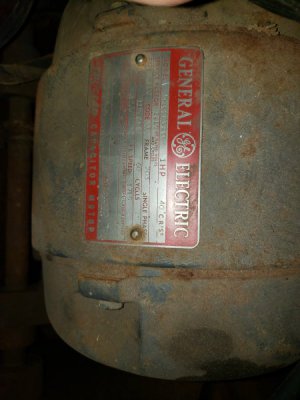For some reason I was struggling to find anything to do with the patents when I looked them up, so thanks! I also dug a bit more on the jackson page of vintage machinery and found a written reference to what I think is my mill. The price list is from 1942, and says it has a 850rpm 3phase motor but the motor in mine is a single phase 1750rpm General Electric tri-clad capacitor start motor that they first released in 1942 (from GE catalong on Vintage machinery). I'm also pretty sure that the motor is physically larger than it should be, because instead of it hanging as the belt tensioner weight it is wedged against the inside of the base casting of the mill. Ill send some pictures of that tomorrow, for now here is the article and my motors plate. Ill check owwm when I get a chance as well. Let me know what you guys think and thanks for all the help!
-
Welcome back Guest! Did you know you can mentor other members here at H-M? If not, please check out our Relaunch of Hobby Machinist Mentoring Program!
- Forums
- GENERAL TYPES OF METALWORKING MACHINES
- ANTIQUE & VINTAGE MACHINERY
- MISC ANTIQUE & VINTAGE MACHINERY
You are using an out of date browser. It may not display this or other websites correctly.
You should upgrade or use an alternative browser.
You should upgrade or use an alternative browser.
Help Identifying Mill
- Thread starter timpet98
- Start date
Not much as far as figuring out more history on the mill, but I'm even more confident with my earlier assumption because there were 8 drilled and tapped holes in the motor mount plate and the new ones were pushed over as far as possible in order to attempt to allow the variable transmission to work. Its slightly less complex than the one in the patent drawings, but that's not all too uncommon for a final design to be different than the patent drawings. It may work with the proper v-belt length but I'm not sure. If it doesn't, I'll get a 1/4" plate that will allow me to push the motor further from the wall it gets wedged against. The reason I haven't posed in a while is that I honestly forgot to take pics of the problem before pulling it apart and getting everything all cleaned up. Then its just been the pain of getting everything taken apart and cleaned of caked burnt grease, and I had to make a screw press to get the spindle bearings out. Not sure if this is common, but it what I was expecting. It had opposing Timken tapered roller bearings right next to each other riding on a double race and then one large standard ball bearing at the rear of the spindle just for alignment. the reason this threw me off, was that there was a bearing retaining nut on the far back of the spindle, so I assumed that once that was off I could push the spindle out the front, but there was another bearing retaining nut wedged almost impossibly inside of the main casting. Here are some more pics of what is going on now, and I'll give an update again if I find any new information out, which I probably will when I start school again on Monday and can't just work in my shop all day. I'll also post again when I get it up and running.... or not because somehow a phone pic is suddenly "too large for the server to upload" not sure what thats about but the bearing race is a Timken-364-D and was a total bear to get out.
Oh, also got the motor sorted, bearings just needed a bit of cleaning and the rotor needed some very light scotchbright to get the rust off for it to clear the stator. It ran before, but sounded cringeworthy and I haven't gotten to the store to buy new wiring yet to test it out again but it feels a thousand times better from just spinning the shaft.
I just took another look over these patents and the first one seems to be a similar mechanism, but my mill only has one of the variable pullies and maintains belt tension by its own axle moving in relation to the fixed spindle and the other end with the motor moving up and down. After getting it all taken apart and put back together, that second patent and it is exactly the same as the oiling system on mine, down to that little bent spring thing.Intesting.....
this one is a "Variable speed transmission mechanism":
https://patents.google.com/patent/US2151189A/en?oq=2151189
and this one an "Oiling system":
https://patents.google.com/patent/US2186477A/en?oq=2186477
The first looks to be from March 1939 one says:
Inventor: Coddington Lloyd
Current Assignee: CONTINENTAL MACHINE SPECIALTIE
The second one was "Filed March 25,' 1938" and says:
Inventor: Coddington Lloyd
Keep posting anything you find, perhaps we can still ID it.
-brino
off topic and a little troubling is one that pops up from the Chinese patent system (if indeed the first two letters mean country):
View attachment 299276


